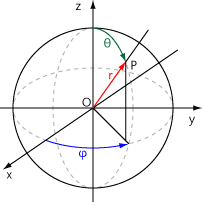| \frac{\frac{d\mathbf{r}}{dr}}{\left>\frac{d\mathbf{r}}{dr}\right|} | = \begin{bmatrix} \sin \theta \cos \phi \\ \sin \theta \sin \phi \\ \cos \theta \end{bmatrix}
|-
!
|
|-
!
|
|}
Iyanaga|이야나가영어 (1977)에서 언급한 '물리학적 표기법'에서 극좌표 가 양의 축으로부터의 기울기라고 가정하면, 에서 까지의 무한소 변위에 대한 선요소는 다음과 같다.
:
여기서
| |
|---|
| |
|---|
| |
|---|
는 각각 , , 가 증가하는 방향의 국소 직교 단위 벡터이고, , , 는 데카르트 좌표계의 단위 벡터이다.
이 오른손 좌표계로의 선형 변환은 회전 행렬이다.
:
이 행렬은 직교 행렬이며, 역행렬은 단순히 전치 행렬이다. 따라서 데카르트 단위 벡터는 다음과 같이 구면 단위 벡터와 관련된다.
:
각 단위 벡터의 미분은 다음과 같다.
| 에 대한 미분 | 에 대한 미분 | 에 대한 미분 |
|---|
| 의 미분 | | | |
|---|
| 의 미분 | | | |
|---|
| 의 미분 | | | |
|---|
5. 2. 미분, 적분
면적 요소는 다음과 같다.
:d영어'''a''' = r2 sin θ d영어θ d영어φ
부피 요소는 다음과 같다.
:dV영어 = r2 sin θ dr d영어θ d영어φ
기울기는 다음과 같다.
:
발산은 다음과 같다.
:
회전은 다음과 같다.
:
라플라시안은 다음과 같다.
:
에서 까지의 무한소 변위에 대한 선요소는 다음과 같다.
:
여기서
:
는 각각 , , 가 증가하는 방향의 국소 직교 단위 벡터이고, , , 는 데카르트 좌표계의 단위 벡터이다.
미분 선요소를 증명하는 공식의 일반적인 형태는 다음과 같다.[5]
:
즉, 의 변화는 개별 좌표의 변화에 해당하는 개별 변화로 분해된다.
이를 현재 경우에 적용하려면, 이 각 좌표에 따라 어떻게 변하는지를 계산해야 한다. 사용된 표기법에서,
:
, x1=r, x2=θ, x3=φ 이다.
따라서,
:
이다.
원하는 계수는 이 벡터의 크기이다.[5]
:
상수 반경 에서 구면의 표면에서 에서 까지, 에서 까지의 면적분은 다음과 같다.
:
따라서 미분 입체각은 다음과 같다.
:
극각 가 상수인 표면(원점을 꼭짓점으로 하는 원뿔)에서의 표면 요소는 다음과 같다.
:
방위각 가 상수인 표면(수직 반평면)에서의 표면 요소는 다음과 같다.
:
에서 , 에서 , 에서 까지의 부피 요소는 편미분의 야코비 행렬의 행렬식에 의해 지정된다.
:
즉,
:
따라서, 예를 들어, 함수 는 삼중 적분에 의해 의 모든 점에서 적분될 수 있다.
:
이 시스템에서 델 연산자는 스칼라장에 대한 기울기 및 라플라시안에 대해 다음과 같은 표현을 제공한다.
:
이는 벡터장의 발산 및 회전에 대해 다음과 같은 표현을 제공한다.
:
:
구면 좌표 에서 직교 좌표 로의 변환은
:
로 주어진다.
구면 좌표 에서 직교 좌표 로의 변환 식을 미분하면
:
를 얻고, 야코비 행렬과 야코비 행렬식은
:
:
이 된다. 따라서 구면 좌표로 나타낸 체적소는
:
가 된다. 또한, 선소의 제곱은
:
가 된다.
표준 기저 를 사용하면, 위치 벡터의 미분은
:
이 되므로, 구체적으로
:
로 표현된다.
표준 내적을 생각하면
:
:
이 되어, 이것들은 정규 직교 기저이다.
곡면 위의 점이 로 매개변수화될 때, 면적소 벡터는
:
로 주어진다.
임의의 벡터장 는
:
:
에 의해 성분 표시된다.
벡터장의 구면 좌표에 의한 미분은
:
:
:
로 주어진다.
스칼라장 의 구배는
:
로 정의되는 벡터장이다.
벡터 미분 연산자를
:
로 정하면
:
로 쓸 수 있다.
벡터장 의 발산은
:
로 정의되는 스칼라장이다.
벡터 미분 연산자를 사용하면
:
로 쓸 수 있다.
벡터장 의 회전은
:
로 정의되는 벡터장이다.
벡터 미분 연산자를 사용하면
:
가 된다.
6. 운동학
구면 좌표계에서 점 또는 입자의 위치는 다음과 같이 표현된다.[7]
:
이때 속도는 다음과 같다.[7]
:
가속도는 다음과 같이 나타낼 수 있다.[7]
:
각운동량은 질량 에 대해 다음과 같이 표현된다.
:
이에 해당하는 각운동량 연산자는 다음과 같다.
:
토크는 다음과 같이 주어진다.[7]
:
운동 에너지는 다음과 같이 표현된다.[7]
:
7. 응용
구면 좌표계는 구 대칭성을 가진 다양한 물리적 문제에 적용된다. 2차원 데카르트 좌표계가 평면에서 유용하듯이, 2차원 구면 좌표계는 구의 표면에서 유용하다. 예를 들어, 방정식 ''x''2 + ''y''2 + ''z''2 = ''c''2로 ''데카르트 좌표''로 설명되는 구는 간단한 방정식 ''r'' = ''c''로 ''구면 좌표''로 나타낼 수 있다.
이러한 단순성은 회전 행렬과 같은 객체를 처리할 때 유용하다. 구면 좌표는 점에 대해 어느 정도의 대칭성을 가진 시스템을 분석하는 데 유용하며, 부피 적분(구 내부), 집중된 질량 또는 전하 주변의 잠재 에너지장, 행성의 대기에서 전 세계 날씨 시뮬레이션 등이 이에 해당한다.
스피커 출력 패턴의 3차원 모델링을 통해 성능을 예측할 수 있다. 패턴이 주파수에 따라 크게 변화하므로, 다양한 주파수에서 얻은 여러 개의 극좌표 플롯이 필요하다. 극좌표 플롯은 많은 스피커가 낮은 주파수에서 전방향성을 나타내는 경향이 있음을 보여준다.
구면 좌표의 중요한 응용 분야는 많은 물리적 문제에서 발생하는 두 개의 편미분 방정식—라플라스와 헬름홀츠 방정식—에서 변수 분리를 제공한다. 이러한 방정식의 해의 각도 부분은 구면 조화 함수의 형태를 취한다. 또 다른 응용 분야는 인체 공학적 설계로, r은 고정된 사람의 팔 길이이고 각도는 팔이 뻗어 나가는 방향을 설명한다. 구면 좌표계는 또한 플레이어의 위치를 중심으로 카메라를 회전시키기 위해 3D 게임 개발에서도 일반적으로 사용된다[4].
8. 타원 좌표계
타원 좌표계도 참조
수정된 구면 좌표계를 사용하여 데카르트 좌표계에서 타원체를 다루는 것도 가능하다.
P를 다음과 같은 등위 집합으로 지정된 타원체라고 하자.
:
ISO 규칙(즉, 물리학의 경우: ''반경'' , ''경사'' , ''방위각'' )에서 P의 점에 대한 수정된 구면 좌표는 다음 공식을 사용하여 데카르트 좌표계 에서 얻을 수 있다.
:
무한소 부피 요소는 다음과 같이 주어진다.
:
제곱근 계수는 행렬식의 속성에서 비롯되며, 상수를 열에서 빼낼 수 있다.
:
본 사이트는 AI가 위키백과와 뉴스 기사,정부 간행물,학술 논문등을 바탕으로 정보를 가공하여 제공하는 백과사전형 서비스입니다.
모든 문서는 AI에 의해 자동 생성되며, CC BY-SA 4.0 라이선스에 따라 이용할 수 있습니다.
하지만, 위키백과나 뉴스 기사 자체에 오류, 부정확한 정보, 또는 가짜 뉴스가 포함될 수 있으며, AI는 이러한 내용을 완벽하게 걸러내지 못할 수 있습니다.
따라서 제공되는 정보에 일부 오류나 편향이 있을 수 있으므로, 중요한 정보는 반드시 다른 출처를 통해 교차 검증하시기 바랍니다.
문의하기 : help@durumis.com
|---|


